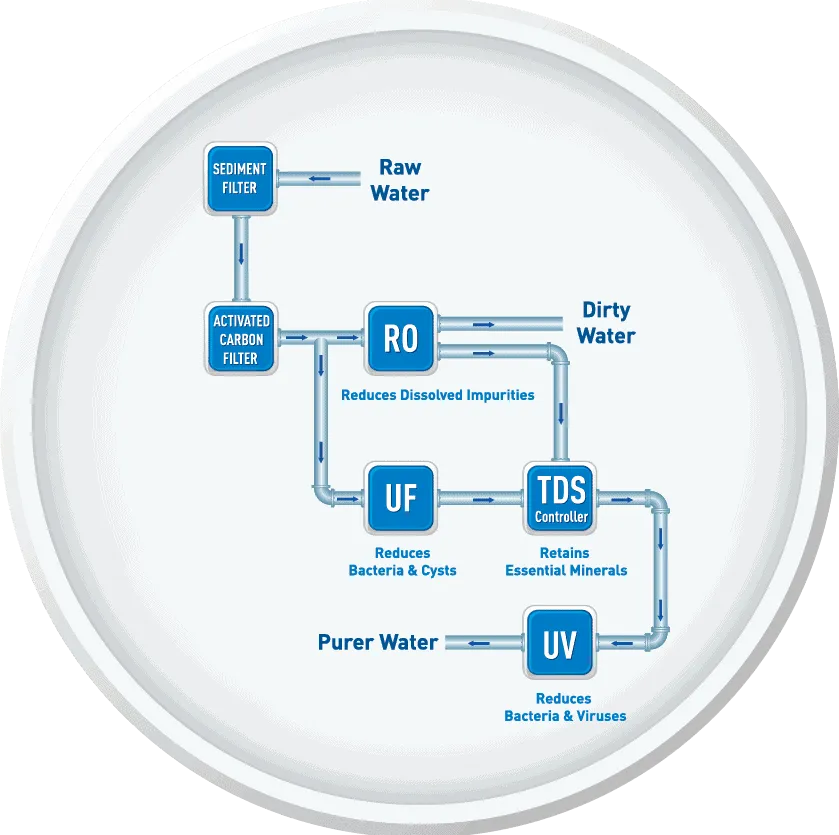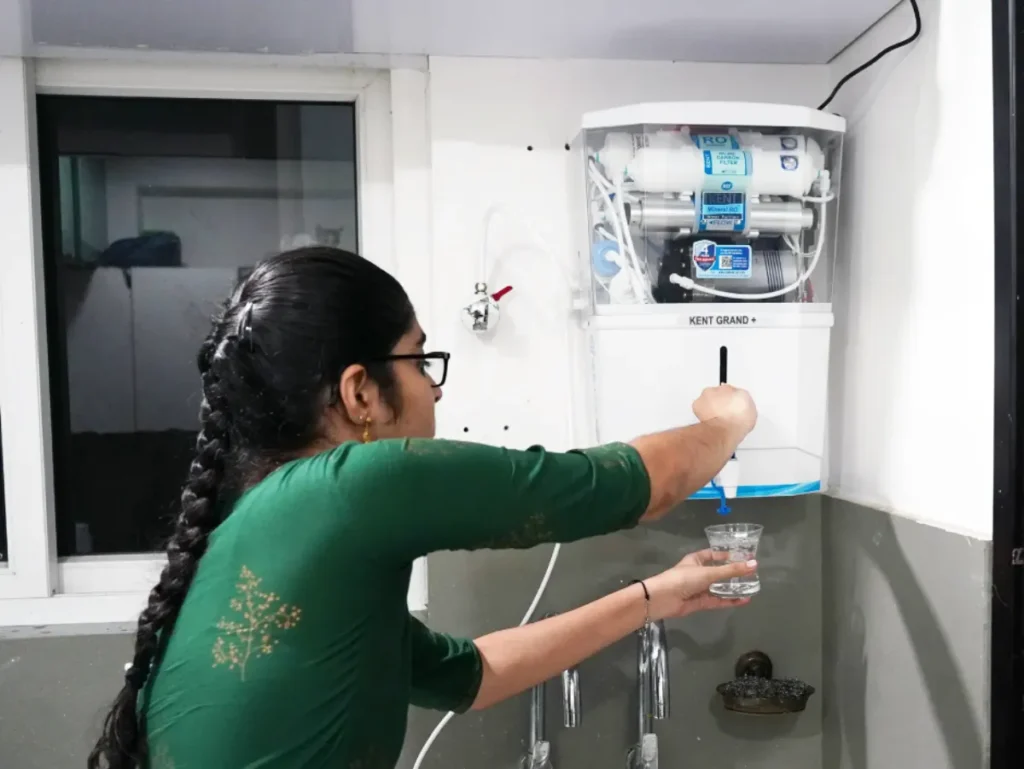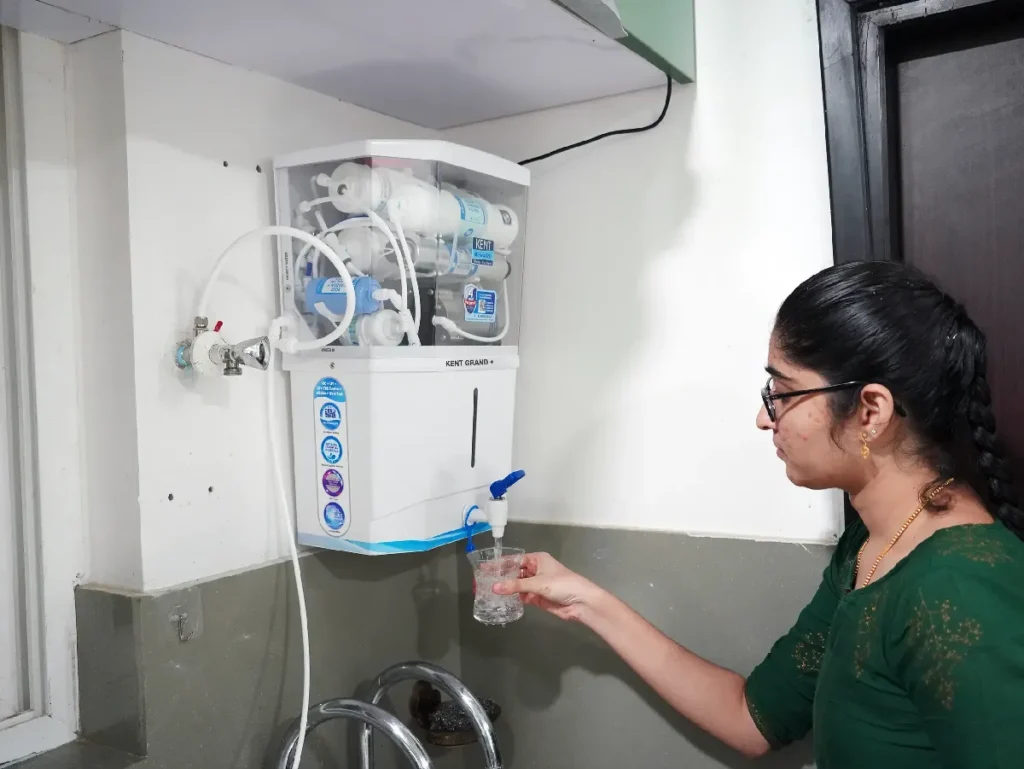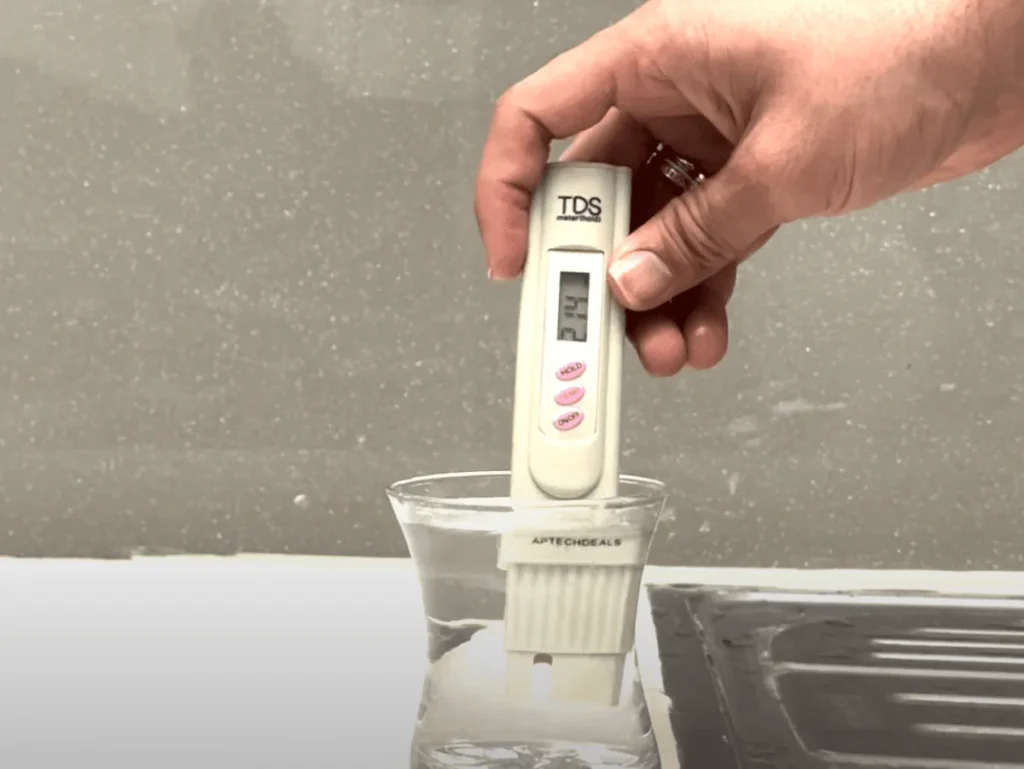Kent Grand Plus is an ideal RO water purifier if you are looking for a machine that removes harmful TDS from the source water. However, like all RO water purifiers, the Kent Grand Plus wastes a lot of water. Despite all the tall claims of Zero Water Wastage, it is practically not feasible. But no one can fault Kent Grand Plus’s performance in removing TDS. We tested the machine and found it perfect for areas with moderate TDS levels without heavy metals, like lead, arsenic, chromium, etc., in the source water.

Kent Grand Plus Pros
- This machine delivers excellent performance by removing all harmful TDS from the source water.
- The 9L water storage tank is ideal for medium-sized families. It is better than the Kent Supreme Alkaline model, which offers an 8L storage tank.
- The UV-LED feature in the storage tank is beneficial because it maintains the water’s purity even during its storage.
- The 20L per hour purification capacity is good.
Kent Grand Plus Cons
- Kent’s claims of Zero Water Wastage are misleading.
- Kent does not provide a sediment prefilter with this product.
- The maintenance costs are high.
Kent Grand Plus Water Purifier Review
Kent Grand Plus is like the Kent Supreme Alkaline, except this water purifier does not provide alkaline water. Otherwise, the performance is the same because it has similar features. Kent Grand Plus offers RO, UV, and UF water purification technologies. Besides, it has a TDS controller and an in-tank UV-LED feature to maintain water purity in the storage tank.

Though this machine is reasonably priced, it incurs high maintenance costs that sometimes discourage users. Besides, Kent does not provide a sediment filter with the package. We suggest users purchase the sediment filter regardless of the quality of the input water source because it traps more prominent and visible impurities to reduce the load on the RO and UF membrane. As a result, you save on maintenance costs.
The water purification process is the same as any other RO water purifier with a seven or eight-stage water purification process. The Kent Grand Plus offers double UV protection because the storage tank contains a UV-LED lamp to prevent water contamination during its storage. Thus, you get high-quality RO-purified water.

Like other Kent RO water purifiers, the Kent Grand Plus also has a TDS controller mechanism to replenish the essential minerals lost during water purification.
This mechanism works by re-introducing untreated source water into the RO-purified water after it emerges through the RO membrane. It is because the RO water purification process removes essential minerals like calcium and magnesium along with the harmful TDS.
This water passes through the UF membrane, the UV lamp, and the post-RO activated carbon filter before collecting in the water storage tank, where it is subjected to additional UV purification to prevent it from getting re-contaminated. This water purifier mechanism works best if the source water does not contain heavy metal impurities like arsenic, lead, iron, etc. But there is no way for the user to determine whether the source water has these pollutants. Therefore, I advise people near chemical industries to avoid using any RO water purifier with a TDS controller mechanism.

The post-RO activated carbon filter removes organic impurities and foul taste from RO-purified water to enhance its taste after RO water purification.
However, Kent Grand wastes a lot of water like any other RO water purifier.
Zero Water Wastage – A No Show
All RO water purifiers have a common complaint of water wastage. Hence, Kent has introduced a new Zero Water Wastage technology that claims not to waste any water during the RO water purification process. However, it is impossible. Kent subverts the process by recycling the rejected water by pumping it into the overhead tank. Though the principle looks good on paper, it is not feasible for various reasons.

Besides the Zero Water Wastage claim, the Kent Grand Plus’s performance is excellent.
Kent Grand Plus Water Purifier Performance
Performance-wise, Kent Grand Plus is comparable with the best in the industry. This water purifier has all the qualities a top-rated appliance should have. It offers multiple-stage water purification techniques like pre-RO activated carbon, RO membrane, UF membrane, UV lamp, and post-RO activated carbon filters.
However, Kent does not provide a sediment filter with the machine. But we suggest users purchase one separately and install it. The filter costs around Rs 700. It traps large impurities and extends the machine’s overall lifespan. Besides, it reduces maintenance costs and enhances the RO membrane purification capabilities.
The TDS controller mechanism has drawbacks because it involves re-introducing untreated source water into the system after the RO water purification stage. It helps restore the essential minerals lost during the RO water purification process. Though many users are apprehensive of this process, it is a safe mechanism because the untreated water undergoes UF and UV purification before it is discharged into the storage tank.

Secondly, the storage tank has an in-tank UV-LED feature to prevent the water inside from re-contaminating. The TDS controller and the post-RO activated carbon filters help improve the water’s taste.
However, the TDS controller mechanism differs from other brands’ mineralizer or mineral enhancer cartridge mechanisms. This mechanism is suitable for areas that do not have heavy metal contaminants in the source water.
We have tested the machine and found its performance to be excellent. The 20L per hour water purification rate is reasonable. The source water in our area has around 600 ppm TDS. After purification, the TDS levels were around 100 ppm, and the water tasted good.

Generally, Kent Grand Plus models are wall mountable. However, unlike other Kent models, the Kent Grand Plus does not have sturdy hooks and sockets. Many users have complained of the machine breaking off from the hooks and falling on the kitchen countertop. Kent needs to improve in this aspect. Though you can keep the Kent Grand Plus on a raised platform or a bracketed stand, the wall-mountable design suits it better.
While the performance is excellent, this machine has drawbacks, like Kent’s misleading Zero Water Wastage claims and high maintenance costs. Nevertheless, Kent Grand Plus is worth its price.
Maintenance Costs – Quite Heavy

All RO water purifiers incur high maintenance costs. This machine is similar because it requires replacing the RO and UF membranes and other filters after 6000 liters of water purification. The frequency of replacing the membranes depends on the TDS levels in the source water.
Ideally, you need to replace the membranes after one and a half to two years. The RO membrane is expensive. Hence, we suggest exploring AMC services offered by authorized Kent service providers. The AMC includes filter and membrane replacement and costs around Rs 4,000 to Rs 5,000, depending on the area.
Many users have complained of poor services offered by Kent, especially during attending complaints and installation. Though we did not face any such problem in our area, Kent must improve its overall service center’s efficiency levels and provide quality after-sales service, especially in extreme competition.
Our Opinion
Kent Grand Plus is worth the money you spend on it because it offers excellent water-purifying performance. Minor issues like unstable wall mounting and lack of sediment filter can be resolved. However, significant issues like water wastage and high maintenance costs still need to be addressed. Nevertheless, this water purifier is a good investment, especially if you live in areas without heavy metal contamination in the water source. It is ideal for areas with water having TDS levels between 500 and 800 ppm.
Frequently Asked Questions
Performance-wise, both machines are similar. However, the Kent Supreme Alkaline model introduces essential minerals through an alkaline media, whereas Kent Grand does not do anything to change the pH value of the output water. The TDS controller mechanism is present in both models.
Secondly, Kent Grand Plus has a post-RO activated carbon filter to remove foul odor and organic impurities. The Kent Supreme also offers activated carbon filtering differently because it uses a silver-impregnated activated carbon filter, whereas the Kent Grand Plus has an unmodified activated carbon filter. The other distinguishing feature is the storage tank capacity. The Kent Grand Plus has a 9L storage tank, whereas the Kent Supreme Alkaline offers an 8L storage capacity.
Kent Grand Plus AMC costs between Rs 4,000 and Rs 5,000, depending on the locality. The AMC includes free service maintenance and replacement of filters and membranes once during the cycle.
The in-tank UV-LED lamp offers ultraviolet purification of the water inside the storage tank. Thus, it prevents the water from getting contaminated again in the storage tank after RO purification.
Ideal For High TDS Water above 500ppm. Avoid This model if the Ground Water Contains harmful metals like Arsenic, Lead chromium, etc.
- Design8
- Water Taste10
- Purification8
- Installation & Service7
- Maintenance7
- Water Savings5
